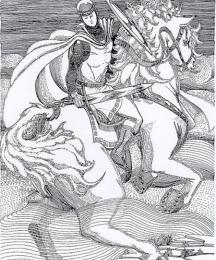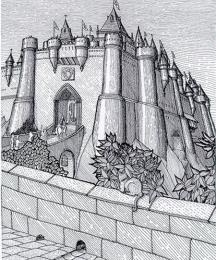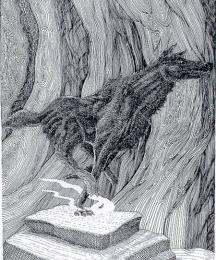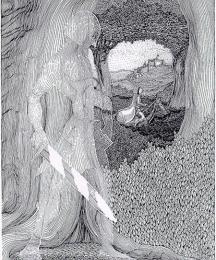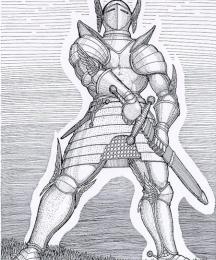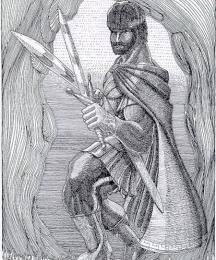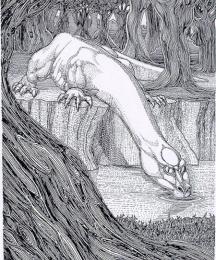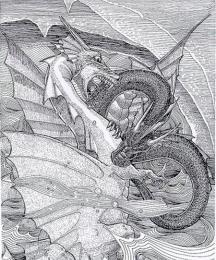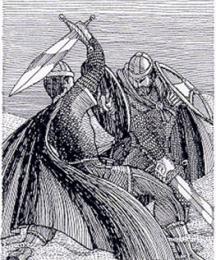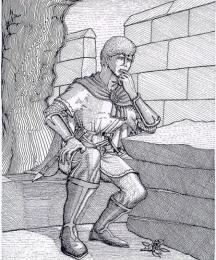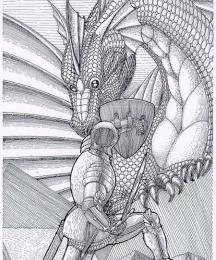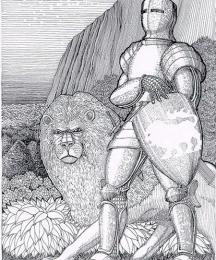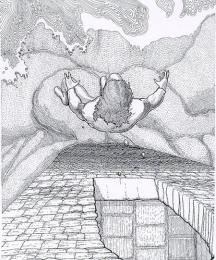Ian Brown (born in Yorkshire, England, on October 8, 1962) has been fascinated with mythology and the Arthurian legends since childhood; and he has been drawing as long as he can remember. Predominantly a self-taught artist, he studied Graphic Design for a time at University as a mature student, but Chronic Fatigue Syndrome postponed the completion of his course. Currently, Brown travels extensively to research, sketch, and gather information and inspiration for his artwork. By combining observation with experience, he creates images that are believable yet have an otherworldly feeling.
Brown includes Malory's Le Morte d'Arthur, Tennyson's Idylls, T. H. White's The Sword in the Stone, and Tolkien's works among his favorite readings; and he lists Albrect Durer, Gustave Doré, the pre-Raphaelites, Arthur Rackham, and Alan Lee among the artists and illustrators whom he particularly admires. His own style varies according to his medium and his subject matter, and his work ranges from small illustrations to large painted panels. "With my illustrations," Brown writes, "the drawing is dictated by the subject matter, and emotions underlie the illustrations, so that there is a feeling of careful control within the drawings: a poised moment of reflection. With many of my larger paintings, the reverse is true: I allow one particular emotion to come to the surface (usually inspired by recalling any particular event in my life and capturing the feeling of that moment) and then pour that feeling into my painting, letting the colours create their own atmosphere." Light is one of the most essential elements in the creation of all his illustrations, small or large; he notes that light
...
Read
More
Ian Brown (born in Yorkshire, England, on October 8, 1962) has been fascinated with mythology and the Arthurian legends since childhood; and he has been drawing as long as he can remember. Predominantly a self-taught artist, he studied Graphic Design for a time at University as a mature student, but Chronic Fatigue Syndrome postponed the completion of his course. Currently, Brown travels extensively to research, sketch, and gather information and inspiration for his artwork. By combining observation with experience, he creates images that are believable yet have an otherworldly feeling.
Brown includes Malory's Le Morte d'Arthur, Tennyson's Idylls, T. H. White's The Sword in the Stone, and Tolkien's works among his favorite readings; and he lists Albrect Durer, Gustave Doré, the pre-Raphaelites, Arthur Rackham, and Alan Lee among the artists and illustrators whom he particularly admires. His own style varies according to his medium and his subject matter, and his work ranges from small illustrations to large painted panels. "With my illustrations," Brown writes, "the drawing is dictated by the subject matter, and emotions underlie the illustrations, so that there is a feeling of careful control within the drawings: a poised moment of reflection. With many of my larger paintings, the reverse is true: I allow one particular emotion to come to the surface (usually inspired by recalling any particular event in my life and capturing the feeling of that moment) and then pour that feeling into my painting, letting the colours create their own atmosphere." Light is one of the most essential elements in the creation of all his illustrations, small or large; he notes that light "gives movement, atmosphere, colour and emotion; without it, there is no illustration."
Ian Brown's work has appeared in various journals, including, among others, Pendragon, The Dragon Chronicle, and 3rd Stone, and on The Arthurian Association of Australia website. In addition to numerous other current projects, he has illustrated Ralph de Tunstall Sneyd's poem, "Vivian and Merlin", which was published separately by Hilltop Press in 2001.
Read
Less



